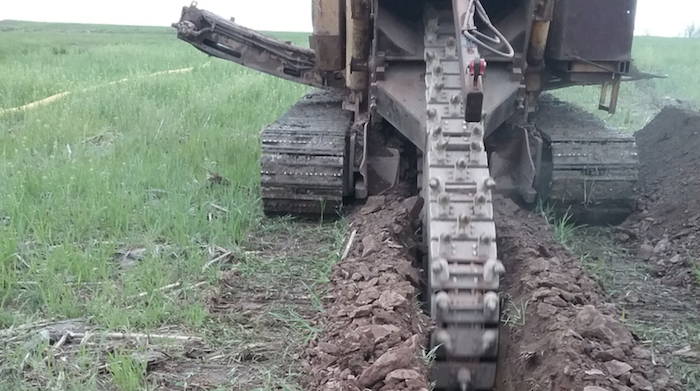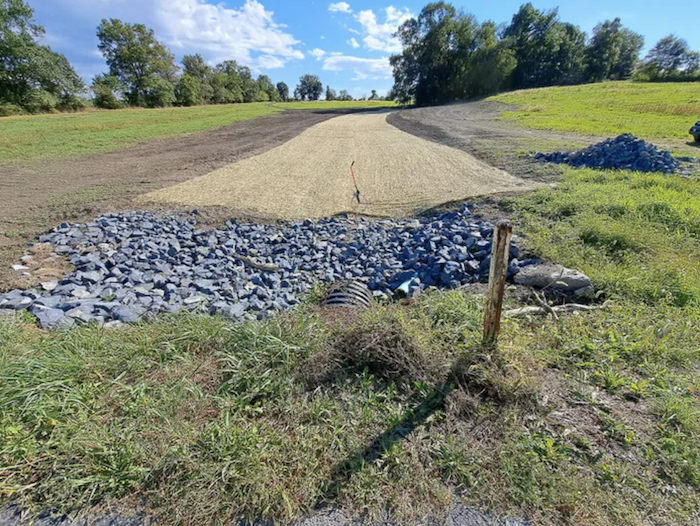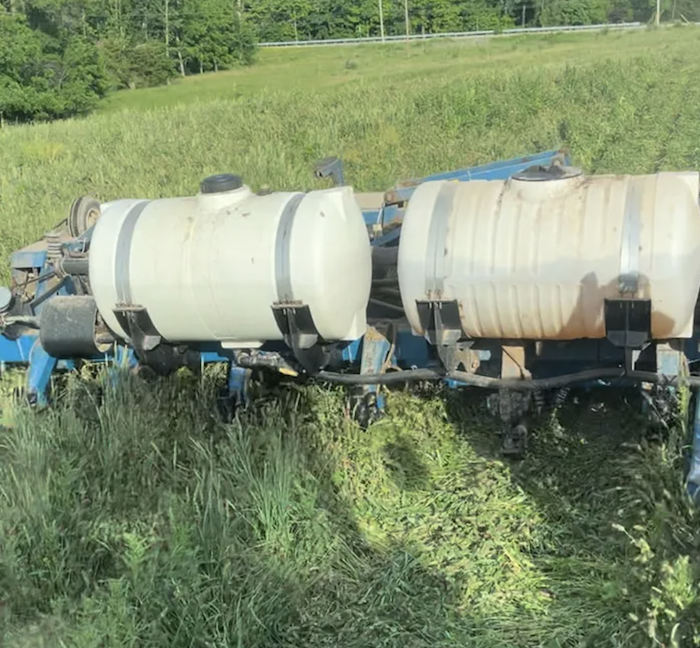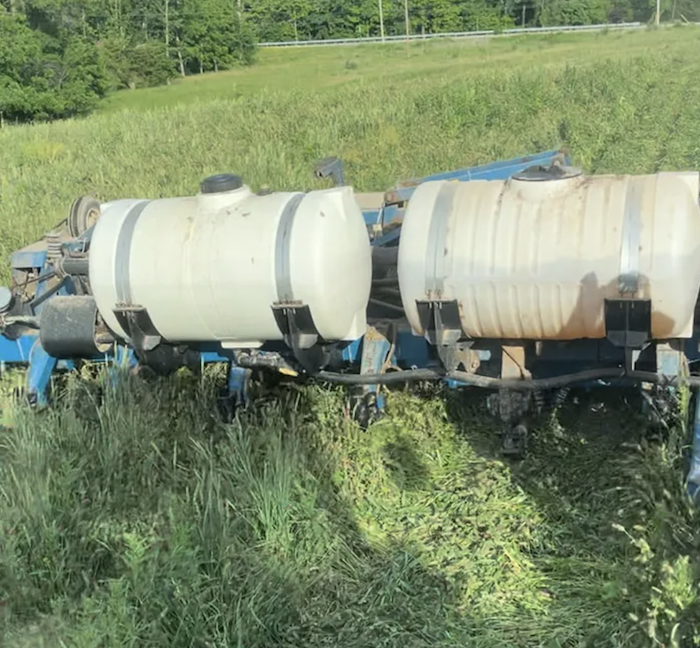It’s a 2-hour drive from Chester County to Adams County, Pa.
But for Ed Wilkinson, moving from the fertile fields of southeast Pennsylvania to the hills around Gettysburg was like landing on the moon, at least in terms of quality farmland.
“When you go from fairly well-drained limestone soils to granite clay, yeah, we had a steep learning curve,” he says.
Using no-till, cover crops and a lot of conservation practices, he and his family are making the most of what they have, but it’s still a learning process, even after moving to their current farm more than 46 years ago.

TILE TRENCHING: Ed Wilkinson purchased his own trencher to do tile work on the farm. Thus far, more than 8 miles worth of subsurface drainage has been installed on the farm. Credit: Brian Sneeringer
“We keep learning different tricks. Things not to do, things to do,” Wilkinson told growers at a recent Pennsylvania No-Till Alliance meeting in Lancaster.
Getty Acres Farm, which Wilkinson owns with his family, includes 1,200 acres of corn, 800 acres of soybeans, 300 acres each of grain sorghum and wheat, 50 acres of cereal rye for cover crop seed and 1,400 acres of hay.
The farm has dabbled with no-till for 30 years, but most of the acreage was transitioned to no-till 20 years ago. One reason: the rising price of diesel.
“When we went all no-till, back some 20 years ago, the diesel fuel price went from less than a dollar a gallon to almost $2 a gallon. My brother and I said, ‘We’re not doing anymore tillage. We’re going to do no-till.’ My dad said it wouldn’t work, but we’ve proved that it has,” Wilkinson says.
Another reason was improving the farm’s soil water-holding capacity. The land consists of shallow 6-inch topsoil. A combination of no-till and cover crops has improved the way water infiltrates and can “suck up” excess water during wet times, he says.
An example of this was the wet spring 2 years ago. Crimson clover, planted the previous fall, dried out the soil just enough that Wilkinson was able to go in and plant green through the living cover crop.
“A few years ago, I wasn’t able to do that,” he says.
But it requires close management, as he saw last year. Spring was much drier than years past, and he couldn’t terminate the cover crops soon enough before they pulled too much water out of the ground. It ended up delaying emergence and hurt his yields, Wilkinson says.
Planter upgrades
No-till is only possible with the right planter, “and this has been a work in progress over many years,” Wilkinson says with a laugh.
He owns a Kinze 2600 12-row planter for corn and a Kinze 3600 16/31 for grain sorghum, soybeans and wheat.
When the farm transitioned to no-till, the corn planter had 2 double-disc openers for applying fertilizer. Wilkinson said the system didn’t provide enough down pressure to cut through the farm’s tough clay soil, so he changed to a single-disc opener and coulter.
“A lot of people told me to get rid of the no-till coulter,” he says. “I followed that advice for about 2 weeks. They went out and as soon as it started getting a little dry, we couldn’t get the unit into the ground. So, the coulters were put back on.”
The coulter only cuts 1 to 1¼ inches, leaving the disk opener to do the rest.
He also switched to shark-tooth row cleaners, which he says are the only row cleaners that won’t get wrapped in cover crop residue in spring.
Another upgrade was adding hydraulic down pressure.
“You can see it on the monitor whether it needs pressure … and after several years, I could tell right from the monitor that I’m getting the seed where it needs to be without having to check it every time,” Wilkinson says.
Adding cover crops
But Wilkinson believes the combination of no-till and cover crops has provided the most benefits.
Cereal rye usually gets planted after corn. “Rye is that crop that seems to germinate and grow, no matter where you put it,” he says.
In 2023, he bought a TerraGator to experiment planting clover with rye, although it remains to be seen if the machine has made much of a difference for cover crop establishment.

GRASS WATERWAY: This waterway with rock outlet is another example of conservation work done at Getty Acres Farm. The farm has 27 grassed lined waterways, totaling 13.5 acres.Credit: Brian Sneeringer
Multispecies mixes are something he would like to increase. The mixes are usually planted after wheat, especially during hot and dry weather when planting a double-crop soybean may not be feasible.
“When I do try, I like to include a legume that will produce nitrogen before corn the following year,” Wilkinson says.
The farm has also experimented with a drone to get cover crops planted. Last year, a drone planted clover in standing wheat; the idea being clover would be established once the wheat was harvested.
“Where it worked, it worked really well. We had a heck of a stand of clover,” Wilkinson says. “Where it didn’t work, it didn’t work at all.”
More consistent yields
Wilkinson said he has seen better soil stability and improved water-holding capacity. Yields are more consistent, averaging 130 to 140 bushels for corn, and 60 to 70 bushels per acre for soybeans. Last year, the farm averaged 36 bushels per acre of soybeans, a down year for sure.

PLANTING GREEN: Much of the farm's land consists of shallow 6-inch topsoil. A combination of no-till and cover crops has improved the way water infiltrates, and it has helped enable Ed Wilkinson to plant green in spring. Credit: Ed Wilkinson
And while those yields won’t break records, Wilkinson says they are much better than past years when terrible droughts led to some years of just 20-bushel corn and even zero-bushel corn a few times.
“With those struggles and with tillage, we knew there had to be a better way,” he says.
Eye on conservation
The farm has done extensive conservation work over the years:
- 27 grassed lined waterways totaling 13.5 acres
- 6,850 feet of terraces
- 2,740 feet of diversions
- 8 miles worth of subsurface drainage
More conservation work is planned, including:
- another 2.7 acres of grass-lined waterways
- 650 feet of terraces
- 3,950 feet of diversions
- 12,200 feet of subsurface drainage
“For us, with our conservation work, it’s what it takes in this heavy clay soil,” Wilkinson says.
Most of this conservation work was done in partnership with Adams County Conservation District, which secured cost share and other funding through the USDA’s Environmental Quality Incentives Program, says Brian Sneeringer, ag conservation technician supervisor.
Erosion controls such as grass-lined waterways, diversions and terraces have become common as more farms transition to no-till and minimum till to reduce erosion.
“As one example, between the ACCD technicians and NRCS technicians, we are installing around 20 grass-lined waterways a year,” Sneeringer says. “Approximately 11 acres each year are taken out of production and set to permanent grass to control erosion.”
While subsurface drainages are not cheap, Sneeringer says these systems can provide the most “bang for the buck” in places where there is too much water and erosion.
“We are extremely blessed to have a large part of the agricultural community that recognizes and actively works with us to reduce cropland erosion,” Sneeringer says. “The fact that farmers here are willing to set aside cropland acres and install practices to control erosion is probably not the norm in much of the surrounding area.”
For Wilkinson, the first years of no-till were challenging.
“I remember the soil getting hard as concrete. It was very tempting to go pull the chisel back out, but we got through it. We got over the hump and things have gotten better,” he says.
It also requires a change in mindset, he adds.
“We’ve had setbacks; we’ve had other issues,” Wilkinson says. “We’ve had equipment issues with cover crops. But all along the way, something told me that it was the way we had to proceed.”







Post a comment
Report Abusive Comment